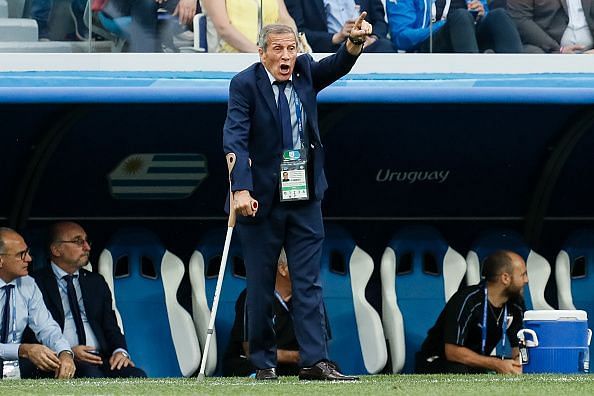
Oscar Tabarez: A 71-year-old's Unrelenting Quest for Glory Despite Chronic Neuropathy
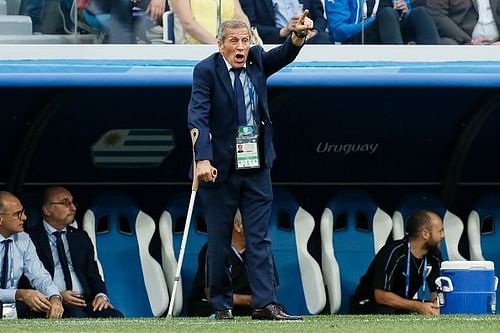
Uruguay may have won two World Cup titles in the past - the first ever in 1930 and that historic triumph in 1950 when they beat favourites Brazil and silenced the Maracana. But since then they have never finished better than fourth.
When the South American nation failed to qualify for the 2006 World Cup after a qualifying playoff loss to Australia, the country turned to one man who has since taken Uruguayan football to new heights; a man who embodied the DNA that has defined their football - Oscar Tabarez.
It wouldn't be his first stint. He had led them to the knockout stages in the 1990 World Cup after all. Although he had found little success after his stints at Penarol and Boca Juniors, Tabarez was brought in with one aim.
He wasn't brought on board simply to help Uruguay qualify for the next World Cup. He was tasked with the transformation of the game in the small country sandwiched between the two continental behemoths - Brazil and Argentina.
National coaches are usually just asked to work with the senior players and qualify for tournaments. Tabarez went a few steps further. Over the next 12 years, he supervised not only the senior side but also the youth development in the country to produce players capable of playing in the national team.
Since he's taken charge, Uruguay have always qualified for the knockout stages, even reaching the semi-finals in 2010 (where Diego Forlan's five goals saw him win the Golden Ball).
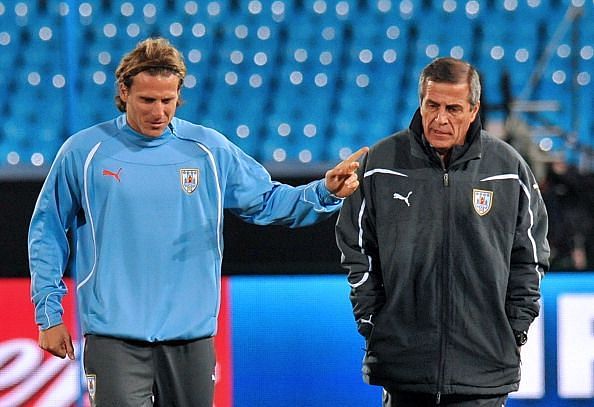
Had he not seen Luis Suarez suspended in 2014 or lost Edinson Cavani to injury in the 2018 edition, the so-called 'World Cup Dark Horses' would surely have given the top sides a serious run for their money.
Nevertheless, Tabarez was the toast of Uruguay for what he had accomplished since taking over in 2006. But for him, what was more important than the results was that the way they played had an effect on the people of the country.
"What I consider more important is that this recognition is beyond winning a football game. There is an image that this group of footballers that work with us has been showing in these years.
"That has had repercussions in all the population, the young people, the women, in sectors where football was not that important." - Tabarez in 2014
It was never a case of feeling proud of what he had done for the team and, in turn, the people. It was more about a sense of satisfaction for what they had achieved as a team.
La Garra Charrua
Uruguay have this unique spirit that has been described as 'La Garra Charrua'. It's difficult to define but broadly speaking it is a term used to describe their never-say-die warrior spirit. It is attributed to the Charrua - a now extinct tribe of warriors that was once the indigenous population of the region.
This spirit has seen its best and worst moments - be it the 1950 Maracanazo or Luis Suarez digging his teeth into Giorgio Chiellini's shoulder at the 2014 World Cup.
Also read: Iconic World Cup Moments - When Uruguay silenced the Maracana
For the Uruguayan team, they are at their best when they have their backs against the wall. The underdog status is what they thrive on; courage in the face of adversity.
And Tabarez is one of the role models for that warrior spirit. The veteran manager suffers from chronic neuropathy (a condition that affects the nerves and impairs movement) which requires him to use a walking stick.
He has even had to use crutches at times and there was that time in 2016 during the Copa America Centenario tournament when he had to use an electric cart for mobility.

Other managers at his age would have retired, opting to spend the rest of their life relaxing after a long career, regaling grandchildren with stories of past triumphs.
Not Tabarez. He is not done yet. At 71, after a quarter-final exit in Russia, he has signed a four-year contract extension with an eye on the 2022 World Cup.
Uruguay captain Diego Godin was asked whether anyone had told Tabarez that it was probably best that he retire to a quiet life away from football and his response perfectly captured that warrior spirit.
“Are you mad or what? No, no, quite the opposite. What gives him vitality is the national team, being with us. I’m convinced of that. It’s life for him.
"The moment he leaves all this behind will be hard. He could say: ‘I’ve done it all now, I’m going home.’ But not him. He works.
"He gives us so much. He’s still standing for us. ‘Upstairs’ he’s lucid, spectacular. We have a huge respect for him and he has such mental strength. He’s an example to us all.” - Uruguay captain Diego Godin
In a way, Tabarez needs football in his life as much as Uruguay needs him. And looking at the way Uruguay has evolved during his time as head coach, he is the obvious choice to take this team a little further.
How Uruguay evolved under Tabarez
In Tabarez's home in Montevideo hangs a quote that has characterised Uruguay's squads over the past decade.
“One must toughen himself but without ever losing tenderness.” - Che Guevara
A decade ago, everyone knew what to expect when they played Uruguay. A well-organised team that sat in two banks of four and played on the counter-attack.
Tabarez knew he couldn't get Uruguay to start playing attacking football as the European teams (or even Brazil). The strategy was simple: win the ball back and send it straight up to Suarez and Cavani who did the rest. The duo has 100 goals between them in the past decade after all.
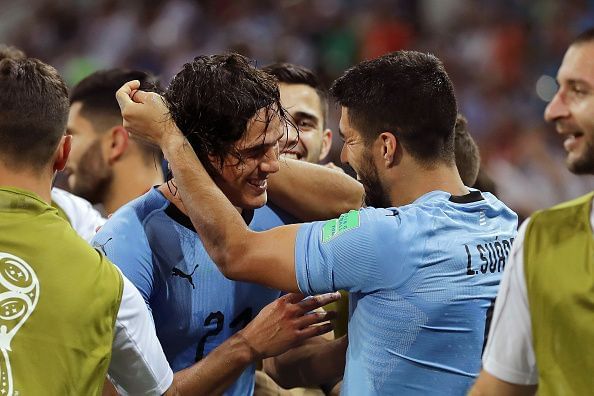
However, that has since changed after more Uruguayan players have settled in at clubs in Europe, especially the youngsters. For the first time, Tabarez had a rich mixture of toughness at the back and technically adept players in the middle.
The back-line still consisted of Diego Godin and Jose Gimenez - staunch followers of the defence-first philosophy that has also been followed by Diego Simeone at Atletico Madrid. Martin Caceres was also from the old school of defending.
But in midfield, it was a different story. Rodrigo Bentancur, Lucas Torreira, Matias Vecino, and Nahitan Nandez (average age: 23) provided Tabarez with the tools to move forward and attack with purpose.
While the underlying pressing game was still the same, these players made it easier for the likes of Cavani and Suarez to receive better service in the final third.
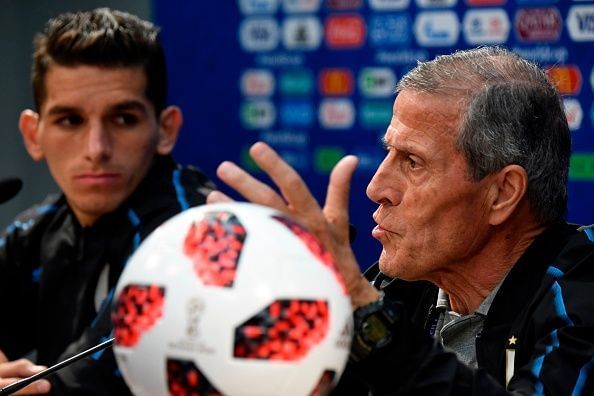
It is that mixture of grit and technical football that has made Uruguay so successful.
Come 2022, Tabarez will have to work with a new core though. The 2018 edition may have been the last World Cup for a number of senior players who could retire from international football after the 2019 Copa America in Brazil.
But having put a system in place for the next generation to come through and put on the shirt of La Celeste, Tabarez may only take this team from strength to strength.
When he eventually does walk into the sunset, he will have done his job and established Uruguay as a team to be feared; just like the team that was unbeaten for nearly half a century when the World Cup first came into being.